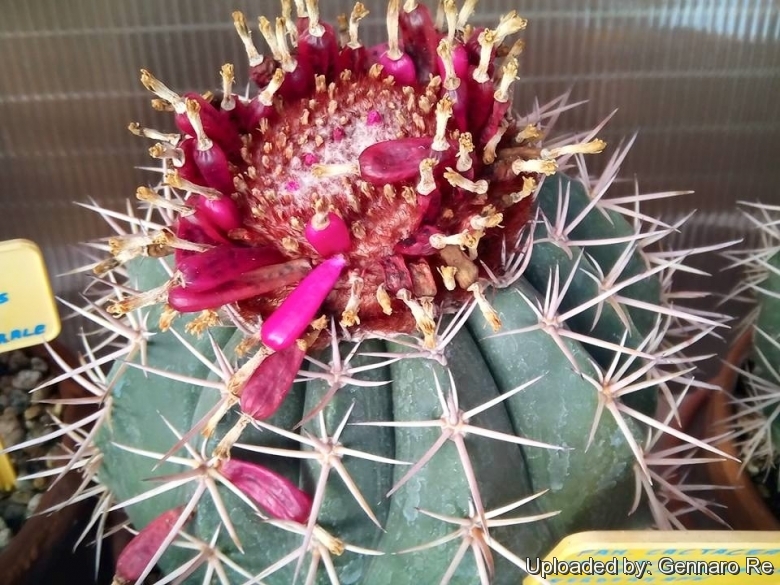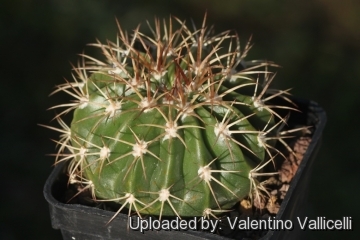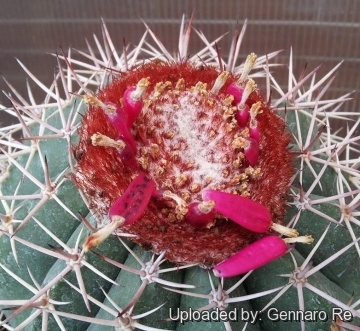
Melocactus salvadorensis Photo by: Gennaro Re
In this species the cephalium is up to 15 cm high, 6-10 cm in diameter, with dense reddish bristles but sparse grayish white wool.The flowers are very small barely exserted above the cephalia pinkish magenta and the fruits are somewhat flattened, deep lilac magenta.
Origin and Habitat: Eastern and southern Bahia and Minas Gerais, (Brazil, Southern America).
Altitude: It grows at elevations from 250 to 1,040 metres above sea level.
Habitat and Ecology: Melocactus salvadorensisSN|26074]]SN|26074]] is widespread and the individuals are scattered on or adjacent to exposed gneiss and granitic rocks and in stony soil in the dry caatinga vegetation in conjunction with Pilosocereus floccosus. It is pollinated by the Ruby-Topaz hummingbirdl. The generation length is about 10 years. The major threats are habitat loss due to agriculture, cattle ranching, gathering of fuel wood, urbanization and collection of plants for ornamental use.
Synonyms:
Common Names include:
ENGLISH: Turk's cap
Description: Melocactus salvadorensisSN|2264]]SN|26074]] is a large Melocactus recognizable by the bluish-green body and reddish brown spines. It is similar to Melocactus ernestiiSN|26074]]SN|2264]] but ribs more triangular-acute and spines shorter.
Habit: Usually stay solitary, mature plants are easily recognizable by their cephalium, that have a covering of wool and orange or red bristles. The immature plant looks like a smallish barrel cactus, and there is nothing in its appearance that would suggest a Melocactus.
Stems: Flattened-globose to pyramidal globose, greyish bluegreen, often very glaucous, 12-20 cm tall, 12-25 cm in across.
Ribs: 8-14, triangular-acute.
Spines: Yellowish to reddish brown, overlaid with grey at first.
Central spines: 1-4,15-30 mm long.
Radial spines: 7-10, 20-46 mm long.
Cephalia: Up to 15 cm high, 6-10 cm in diameter, with dense reddish bristles but sparse grayish white wool.
Flowers: Small inconspicuous, barely exserted above the cephalia, opening in late afternoon, pinkish magenta, to 25 mm long and 12 mm in diameter.
Fruits: Club shaped, somewhat flattened, deep lilac magenta, to 17 mm long.
Notes: The most remarkable part of a Melocactus is its cephalium a bristle-coated structure on the summit of the plant, only Melocactus, and the similar genus Discocactus possesses this type of permanent, apical, hatlike appendage. It’s only when a Melocactus reaches maturity that the cephalium begins to grow. Cylindrical, with a diameter distinctly smaller than that of the plant body below, the cephalium will keep growing for the rest of the plant’s life, but the body of the plant stops growing the moment the cephalium starts to form. As the plants age the cephalium doesn’t increase in circumference it will steadily grow taller.
Bibliography: Major references and further lectures
1) Braun, P., Machado, M., Taylor, N.P. & Zappi, D. 2013. Melocactus salvadorensis. In: IUCN 2013. “IUCN Red List of Threatened Species.” Version 2013.2. <www.iucnredlist.org>. Downloaded on 13 February 2014.
2) Stuart Max Walters “The European garden flora. 3.[Angiospermae], Dicotyledons. [Casuarinaceae to Aristolochiaceae]” Cambridge University Press, 1989
3) Edward Anderson “The Cactus family” Timber Press, Incorporated, 2001
4) David R Hunt; Nigel P Taylor; Graham Charles; International Cactaceae Systematics Group. "The New Cactus Lexicon" dh books, 2006
5) Urs Eggli, Leonard E. Newton "Etymological Dictionary of Succulent Plant Names" Birkhäuser 2004
6) Taylor, N. P. 1991. "The genus Melocactus (Cactaceae) in Central and South America." Bradleya 9: 1–80.
7) Nigel Taylor, Nigel P. Taylor, Daniela C. Zappi, “Cacti of Eastern Brazil” Royal Botanic Gardens, Kew, 15/gen/2004
8) H. Krainz “Die Kakteen: : eine Gesamtdarstellung der eingefuhrten Arten nebst Anzucht- und Pflege-Anweisungen Herausgegeben von H. Krainz.” Stuttgart 1973
9) Urs Eggli, Leonard E. Newton: “Etymological Dictionary of Succulent Plant Names.” Springer, Berlin / Heidelberg 2010
 Melocactus salvadorensis Photo by: Valentino Vallicelli
Melocactus salvadorensis Photo by: Valentino Vallicelli Melocactus salvadorensis Photo by: Gennaro Re
Melocactus salvadorensis Photo by: Gennaro ReCultivation and Propagation: These cacti are not the easiest things to grow and aren’t plants for beginners. In northern hemisphereMelocactus glaucescens grows from April to October, it can’t endure long stretches of total dryness, and also too much water will rot it, as its weak root systems tends to be inefficient at sucking up water from wet soil. Nonetheless, again as a result of their tropical origins, they need a fair amount of water, but allow the soil to dry quite a bit before watering again. Melocactus rests from October to April but can’t stand cold, or even fairly cool temperatures, so is indispensable to keep it above 8-12°C at all times, severe damage or death occurring at temperatures that the great majority of cacti wouldn’t mind in the least and prefer more frequent water in winter than other cacti, say once a month. Do not feed in winter.
The root system is weak and generally resents being repotted and can take a long time to re-establish. The soil mix should be very quick draining, prefers very bright light, not as much as the most arid growing cacti, but plenty nonetheless.
Propagation: Exclusively by Seeds. Sow in February-march in a light, sandy, porous soil. Cover germinating tray with glass to prevent seed from drying out. Germination is most successful at a temperature of 18 to 22° C.













